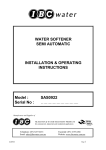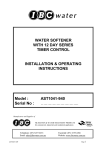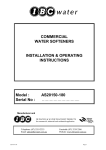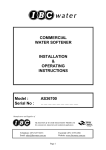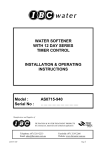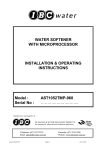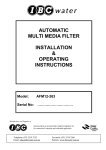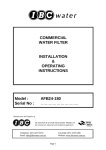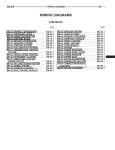Download AS1029-E - IBC Water
Transcript
WATER SOFTENER SERIES 500 12 DAY TIMER INSTALLATION & OPERATING INSTRUCTIONS Model : Serial No : AS1029-E ……………………….. Manufacturer and Supplier of FILTRATION & WATER TREATMENT PRODUCTS for commercial, industrial and residential application Telephone: (07) 3219 2233 Email: [email protected] AS1029-E Facsimile: (07) 3219 2266 Website: www.ibcwater.com.au Page 1 HARDNESS TEST 1. Water to be tested should be taken from a tap after the water softener 2. Measure 10ml of water into plastic bottle supplied (approximately 1/3 full) 3. Add one Yes/No tablet to sample water, replace cap and shake until tablet has completely dissolved. (NOTE: do not handle Yes/No tablet with fingers) 4. The final colour to be obtained for soft water is green. (Note: The shade of green may vary.) If the colour turns red, the water is above 20 mg/l hardness, therefore another regeneration is recommended. 5. Rinse plastic bottle after each test has been completed. 6. When used as above, the tablets change the colour from green to red at a hardness of approximately 20ppm based on a sample volume of 10mls. Other hardness test kits are available for more accurate testing eg. Hardness Tablets Directions: Take a 50ml sample of water in a screw capped bottle. Add one (1) tablet to sample, shake or crush to disintegrate. Repeat until last trace of reddish tinge disappears. The final colour is usually blue but with some water a greyish coloured end point is obtained. Using 50ml sample Hardness ppm = (number of tablets x 40) - 20 LR (BW) Tablets Directions: Take a 100ml sample of water in a screw capped bottle. Add one (1) tablet to sample, shake or crush to disintegrate. Repeat until last trace of reddish tinge disappears. The final colour is usually blue but with some water a greyish coloured end point is obtained. Using 100ml sample Hardness ppm = (number tablets x 2) – 1 Contact IBC Water if further details are required. AS1029-E Page 2 WATER SOFTENER CALCULATIONS MODEL AS1029-E To ascertain DAYS between regeneration periods the following data or estimations are required. (Let N be the number of days to be calculated) .1. ð Water Hardness in mg/l .2. ð Water Softener Hardness Removal Capacity from Table 1 in grams call ð call ð .3. call ð H C Daily Water Usage in litres ð D For household situations allow 250 litres per person per day. CALCULATION N = 1000 x C DxH Select nearest lower whole number If necessary consult your dealer or IBC Water Treatment for advice on setting up the softener. EXAMPLE Household use for 4 people on 220 mg/l hard water using Model AS1029-E at 2030 grams capacity. N AS1029-E = 1000 x 2030 1000 x 220 = 9.2 days = 9 days Page 3 LOCATION & INSTALLATION 1. The softener should be located indoors or protected from the weather. 2. The softener requires an inlet water pressure between 140kPa (20psi) and 690kPa (100psi) and 240 volt 10 amp electric power supply. 2. The softener should service all water lines in the house except the toilet and outside taps. The softener should be positioned on a level flat surface close to a drain or any other properly trapped waste outlet. The brass adaptors supplied are suitable for 20mm (3/4") female fittings and the softener should be connected to the supply with raw water to the inlet connector and softened water lines to the outlet as indicated on the valve. If soldering fittings are used, the adaptors should be removed from the valve whilst the fittings are being soldered. 3. When facing the front of the control the inlet is to the right and the outlet is to the left. 4. The system pressure must be between 140 kPa and 690 kPa psi. 5. If the system pressure is greater than 690kPa psi a pressure reducing valve must be installed. 6. The unit must be installed in accordance with local codes. 7. Do not over tighten connections. 8. Drain line ID must be at least 12mm. 9. Teflon tape should be used when installing he drain fitting into the control valve. 10. The drain line must be free of kinks. 11. A safety float with an air check is installed. 12. Insure all connections are tight. Note: DO NOT use teflon tape when connecting the fitting kits to the control valve. 13. There are two drain lines, one from the brine tank and one from the softener valve, these lines must have an air gap of at least 40mm or twice the pipe diameter at the drain entrance. The drain line from the brine tank is gravity fed and hence the drain is required to be below the outlet elbow on the tank. 14. The drain line from the softener valve is under pressure during regeneration but for correct operation a maximum of 2.4m of 15NB pipe with no rises can be connected. A manual Bypass should be installed. AS1029-E Page 4 PLACING THE SOFTENER IN SERVICE 1. Depress all Skipper Wheel Tabs. 2. Turn knob (B) counter-clockwise until cam follower (G) has fully depressed drain valve stem (H). 3. Ensure the power is turned off at this stage. Open the installed inlet valve slightly and slowly fill the mineral tank with water. Air and water will be expelled from drain line during the filling process. When the mineral tank is full and the stream of water from the drain line is steady, with no air bubbles, turn knob (B) counter-clockwise until cam follower (G) springs back into position, allowing the drain valve stem (H) to return to the shut-off position. Open the inlet valve fully. The salt storage tank will automatically fill to the proper level. To check the level, remove the cabinet cover plate. If for any reason it does not fill to this level, the bribe valve float must be raised or lowered as required. This level will ensure the softener is set to produce maximum hardness removal. 4. Again turn knob (B) counter-clockwise until cam follower (G) has fully depressed drain valve stem (H). Water will run from drain line and water in the salt storage tank will be lowered approximately to the centre of the brine valve air shut-off assembly. Let water run about 5 minutes longer or until water is clear and then turn timer knob (B) counterclockwise until cam follower (G) springs back into position, again allowing the drain valve stem (H) to return to the shut-off position. Open installed outlet valve and be sure that the installed by-pass valve is closed. BRINE TANK 1. Place at least 25kg of a coarse refined grade of salt (Water Softener Salt) in the brine tank and always maintain dry salt above the water level. The tank can hold up to 50kg of coarse salt. 2. Periodically it will be necessary to allow the salt to "run-out" and clean out the brine tank of accumulated silt and insoluble material. REGENERATION This automatic water softener is designed for a minimum complete regeneration time of 70 minutes. Under normal conditions the regeneration cycle should be set to 70 minutes. However, if the pressure is low, the time may have to be increased to 90 minutes. AS1029-E Page 5 REGENERATION FREQUENCY The softener can be set to regenerate from once per day up to once per 12 days. To determine the correct number of regenerations refer to the Tables below for the model softener installed. The skipper wheel tabs are pushed in fully for the days selected for regeneration. The factory setting for the actual time of regeneration is 3am. The tables below are based on an average daily water usage of 250 litres per person and using the maximum salt dosage to provide maximum capacity. The tables indicate a suggested number of regenerations per 12 day period. The tabs selected will have to suit the suggested number eg. For 6 regenerations, select tabs, 1, 3, 5, 7, 9, 11. From the left column locate the number in the family, reading along and down from the hardness column, where the column intersect gives the number of regenerations for every 12 days. MODEL AS0715-E No. in family 1 2 3 4 5 6 Hardness MG/L CACO3 50 1 1 1 1 1 1 100 1 1 1 2 2 2 150 1 1 2 2 3 3 200 1 2 2 3 3 4 250 1 2 3 3 4 6 300 1 2 3 4 6 6 350 2 3 4 6 6 400 2 3 4 6 6 450 2 3 4 6 500 2 3 6 6 400 1 2 3 4 4 6 450 1 2 3 4 6 6 500 1 2 3 4 6 6 400 1 2 2 3 4 4 450 1 2 3 3 4 6 500 1 2 3 4 4 6 MODEL AS0922-E No. in family 1 2 3 4 5 6 Hardness MG/L CACO3 50 1 1 1 1 1 1 100 1 1 1 1 1 2 150 1 1 1 2 2 2 200 1 2 2 2 2 3 250 1 1 2 2 3 3 300 1 2 2 3 3 4 350 1 2 3 3 4 6 MODEL AS1029-E No. in family 1 2 3 4 5 6 AS1029-E Hardness MG/L CACO3 50 1 1 1 1 1 1 100 1 1 1 1 1 1 150 1 1 1 1 2 2 200 1 1 1 2 2 2 250 1 1 2 2 2 3 300 1 1 2 2 3 3 350 1 2 2 3 3 4 Page 6 AS1029-E Page 7 541-030 VALVE Water Conditioning Control System Installation, Operating and Maintenance Manual AS1029-E Page 8 Cycle Flow Diagrams The service cycle position directs untreated water to flow down through the resin bed in the mineral tank and up through the riser tube. The water is conditioned when passing through the resin. The backwash cycle position directs water to flow down through the riser tube and up through the resin bed and to drain. Foreign material and resin fines are flushed from the mineral tank during this cycle to prepare the resin bed for brining. The slow rinse cycle position directs a slow flow of water down through the riser tube and up through the resin bed to drain. This slow flow of water pushes the brine solution through the resin bed. The fast rinse cycle position directs water to flow down through the riser tube and up through the media bed and to drain. Foreign material is flushed from the mineral tank during this cycle. AS1029-E In brine draw, concentrated salt brine is drawn from the brine tank and directed to flow down through the riser tube and up through the resin bed to the drain. Brine is drawn until the air check in the brine tank closes. Page 9 Programming General Information Set Time of Day The control valve is designed to initiate regeneration according to pre-set factory parameters. Following the instructions contained in this section will allow the installer to customise the program for the users exact needs. The regeneration cycle is controlled by the time cam located on the front of the timer assembly. The brine & slow rinse cycle can be adjusted from 50 minutes to 95 minutes in 5 minute increments. The backwash and fast rinse cycles are not adjustable. Factory Default Settings The following default cycle settings are preset into the control valve. Cycles: Backwash Brine / Slow Rinse Fast Rinse 11 1/2 minutes 70 minutes 4 1/2 minutes Set Time of Regeneration 1. Remove the front dust cover from the timer assembly. 2. Rotate the Time of Regeneration plate (A) until the desired time appears in the window. Note A.M. or P.M. AS1029-E 1. Remove the front dust cover from the timer assembly. 2. Turn the Timer Knob (B) until the alignment mark located on the Time of Day Gear (C) points directly to the correct time of day. Note A.M. or P.M. Set Regeneration Frequency 1. Remove the front dust cover from the timer assembly. 2. Pull all skipper wheel tabs up. 3. Rotate skipper wheel (D) until the number one tab aligns with the DAY mark (E) 4. Starting with the number one tab, push down the tabs to determine the days on which regeneration is required. Regeneration Cycles The backwash and fast rinse cycles are nonadjustable. Adjusting the brine and slow rinse cycle can be accessed according to the following procedure: 1. Loosen the screw located on top of the timer cover, remove front dust cover from timer assembly. 2. Turn Timer Knob (B) until setscrew on the time cam is visible. 3. Loosen setscrew, and using the alignment mark (F) located on the lower cam, move timing cam to the desired length of time. 4. Tighten setscrew and install dust cover. Page 10 Electromechanical Power Head Parts List Item P/N Description Qty 1. 2. 3. 4. 5A. 5B. 6. 7. 8. 9. 10. 11A. 11B. 12A. 12B. 13. 14. 15. 16. 17. 18. 19 20. 21. 22. 23. 24. 25. 26. 27. 28. 29. 30A. 30B. 31. 32A. 32B. 33. 34. 35. 15-76 529-309 525-303 52-308 529-232-1 529-232-2 19-3 529-218 529-212 529-333-1 15-185-10 525-274-1 525-274-2 525-241-2 525-241-4 525-205 15-87 529-239-1 529-219-3 401-7 185-0221-1 529-286 529-280 15-92-2 525-279-4 15-185-10 15-76 30-77 * 516-221 15-185-10 14-11 525-260 525-254-2 525-254-5 529-234 ** 529-220-1 529-220-2 529-290-14BK 28-8-28 28-142-2 Screw Time Dial Spring Washer, (Small) Locating Dial Gear, Time of Day (12 Day) Gear, Time of Day (7 Day) C -clip Actuator Spindle, Actuator Housing, Power Head Screw, Day Selector Wheel Washer, Day Indicator (12 Day) Washer, Day Indicator (7 Day) Day Selector Wheel (12 Day) Day Selector Wheel (7 Day) Spring Washer, (Large) Screw, Head Mount Cycle Cam & Knob Assembly Drain Plunger Assembly return Spring, Drain Plunger O-ring, Plunger Cap Plunger Cap Retainer, Drain Plunger Screw, Retainer Switch & Terminal Assembly Screw, Switch Screw, Timer Motor Timer Motor Return Spring, Main Diaphragm Screw, Ratchet Washer, Ratchet Ratchet Gear Ratchet (12 Day) Gear Ratchet (7 Day) Front Cover Rear Cover (Gray) Rear Cover (White) Solenoid Cord Strain Relief Power Cord (120 Volt) 1 1 1 1 1 1 1 1 1 1 1 1 1 1 1 1 4 1 1 1 1 1 1 1 1 2 2 1 1 1 1 1 1 1 1 1 1 1 1 1 * Indicate Voltage ** Indicate Opaque or Clear AS1029-E Page 11 AS1029-E Page 12 Valve Body Parts List Item P/N Description Qty 1. 2. 3. 4. 5. 6. 7. 8. 9. 10. 11. 12. 13. 14. 15. 16. 17. 18. 19. 20. 21. 22. 23. 24. 25. 26. 27. 28. 29. 30. 31. 32A. 32B. 33. 34A. 34B. 35A. 35B. 36. 37. 15-88 15-90 413-134 * 413-60 413-58 413-62 413-61 413-59 541-208-2 541-206 541-239 541-246 541-325 428541-221 15-89 413-13 541-254 186-111-N 541-250-1 19-19 541-243 529-244 541-244 185-024-1 541-204 185-028-12 541-256 19-3 516-221 19-90 185-231-1 186-105 541-232 185-211-1 185-214-1 541-205 541-218 185-029-1 541-257-1 Screw, Backcap Screw, Solenoid Mount Solenoid Coil (Specify Voltage) Spacer Guide Spring, Plunger Plunger, Solenoid Diaphragm, Solenoid Backcap, 5 Cycle Fast Rinse Seal, Backcap Return Spring, Check Disc Check Disc Gasket, Injector Injector (Specify Size) Cover Plate, Injector Screw, Injector Mount Filter Screen, Injector Spring Clip O-ring, Brine Fitting Brine Fitting C-Clip, Backwash Flow Adjuster Backwash Flow Adjuster w/o-rings Gasket, Cross Over Port Body Stem Assembly O-ring (Small), Seat Insert Seat Insert O-ring (Large), Seat Insert Main Diaphragm C-clip, Main Diaphragm Return Spring, Main Diaphragm Screw, Adapter Ring O-ring, Structural Tank O-ring, Park Tank Adapter Ring O-ring, 13/16" Riser Adapter O-ring, 1.050" Riser Adapter Power Cord (120 Volt) 13/16" Riser Adapter 1.050" Riser Adapter Valve Body & Seal 3 1 1 1 1 1 1 1 1 1 1 1 1 1 3 1 1 1 1 1 1 1 1 1 1 1 1 1 1 2 1 1 1 1 1 1 1 1 1 4 * Indicate Voltage AS1029-E Page 13 AS1029-E Page 14 Troubleshooting Guide Problem 1. Unit fails to regenerate. Cause a. Faulty electrical circuit. b. Defective clock motor. c. Low inlet pressure. d. Drain line restricted. e. All skipper tabs in the "out" position. 2. Hard water to service. f. The brine injector is plugged. g. Main diaphragm is torn. h. Timer knob out of alignment with Time Gear. i. Defective solenoid coil. a. The bypass valve is open or faulty. b. No salt in storage tank. c. Not enough water in the storage tank. d. e. f. g. h. i. 3. Excessive salt usage. 4. Loss of resin. 5. Salt water to service. 6. Control fails to draw brine. Unit fails to draw brine. Excessive water usage. Unit not regenerating. Loss of resin. Change in raw water hardness. Leak at the distributor tube. i. a. b. c. d. e. f. g. h. i. a. Excessive water in storage tank. a. b. Regeneration is taking place too frequently. c. Faulty safety float. a. Faulty air check in storage tank. b. Leak at the distributor tube. b. c. Backwash flow improperly adjusted. a. Brine/slow rinse cycle time set too short. b. Excessive water in the storage tank. c. Brine injector undersized. a. Brine injector plugged. b. Filter screen plugged c. Loose brine line connection. d. Drain line is restricted e. Low inlet pressure. f. Main diaphragm is torn. g. Solenoid plunger stuck open. 7. Continuous flow to drain. a. Drain plunger stuck open. b. Clock motor stalled. 8. Loss of water pressure. a. Iron build up in mineral tank. b. Lower distributor basket crushed. c. AS1029-E Solution a. Verify electrical service (fuse, circuit breaker, light switch, pull chain, power cord). b. Replace the clock motor. c. Verify that the service inlet pressure is a minimum of 20 psi. d. Insure the drain line is free of kinks. e. Push desired number of skipper tabs to the "in" position. f. Clean or replace injector. g. Replace diaphragm. h. Realign the Knob and Gear. Resin has lost mechanical strength. Test and replace the solenoid coil. Close bypass valve. Add salt. Verify that the safety float is properly set. See symptom/cause # 6. Check regeneration frequency. See symptom/cause # 1. See symptom/cause # 4. Test water hardness. Verify that the distributor tube is seated correctly and is not cracked. Verify that the safety float is properly set. Check regeneration frequency. c. Replace safety float. a. Clean or replace air check. b. Verify that the distributor tube is seated correctly and is not cracked. c. Verify the backwash flow. a. Verify cycle time. b. Verify that the safety float is adjusted correctly and properly. c. Verify proper injector selection. a. Clean and replace injector. b. Clean and replace screen. c. Verify that all the brine line connections are tight. d. Insure that the drain line is not kinked or plugged. e. Verify that the service inlet pressure is a minimum of 20 psi. f. Replace diaphragm. g. Clean or replace the solenoid plunger assembly. a. Clean or replace the drain plunger assembly. b. Replace the clock motor. a. Increase salt dosage or regenerate more frequently. b. Replace basket and verify that the distributor is cut 1/2 inch below the top of the tank threads. c. Replace resin Page 15 Parts Replacement General Information Main Diaphragm Replacement Familiarise yourself with the parts replacement procedures and component parts thoroughly before attempting any repair. Insure that the unit is in the bypass position and relieve the system pressure before attempting any repair procedure. WARNING! Disconnect all electrical power to the unit before attempting and repair procedure. Required Tools The following tools are required to perform routine maintenance on this valve: Phillips Screwdriver Needle Nose Pliers Adjustable Wrench Small Standard Screwdriver Timer Assembly Replacement 1. Disconnect all electrical power to the control. 2. Place the bypass valve into "bypass" position. 3. Remove the front dust cover from the timer assembly. 4. Relieve the system pressure by using a screwdriver to press down on the drain plunger opening the drain line. 5. Disconnect the solenoid cable from the solenoid coil. 6. Remove the four (4) head mounting screws. 7. Lift the timer assembly away from the valve body. 8. Follow these steps in reverse to reinstall the timer assembly. Note: Prior to re-instalment insure that the main return spring is centred over the main diaphragm. Timer Motor Replacement 1. Disconnect all electrical power to the control. 2. Remove both the front dust cover and the rear timer cover. 3. Disconnect the two (2) wire nuts from the timer motor leads. 4. Remove the two (2) motor mount screws. 5. Lift the motor away from the timer assembly. 6. Follow these steps in reverse to reinstall the timer assembly. AS1029-E 1. Disconnect all electrical power to the control. 2. Place the bypass valve into the "bypass" position. 3. Remove the front dust cover from the timer assembly. 4. Relieve the system pressure by using a screwdriver to press down on the drain plunger opening the drain line. 5. Disconnect the solenoid cable from the solenoid coil. 6. Remove the four (4) head mounting screws. 7. Lift the timer assembly away from the valve body. 8. Remove the c-clip from the centre of the diaphragm. 9. Lift the diaphragm away from the body stem assembly. 7. Follow these steps in reverse to reinstall the timer assembly. Note: Prior to re-instalment insure that the main return spring is centred over the main diaphragm and that the outside edges of the main diaphragm are tucked into the valve body. Drain Plunger Replacement 1. Disconnect all electrical power to the control. 2. Place the bypass valve into "bypass" position. 3. Remove the front dust cover from the timer assembly. 4. Relieve the system pressure by using a screwdriver to press down on the drain plunger opening the drain line. 5. Remove the retaining screw located below the "Time of Day" gear. 6. Lift the retainer down and away from the timer assembly. 7. Press down on the drain plunger to remove it from the valve body. 8. Inspect the plunger o-rings and centre cup for wear. 9. Clean out the plunger orifice in valve body. 10. Use a Dow 111 Silicone based lubricant to lightly lubricate the plunger o-rings and the valve body orifice. 11. Follow these steps in reverse to re-install drain plunger. Page 16 Injector and Filter Screen Replacement 1. Disconnect all electrical power to the control. 2. Place the bypass valve into the "bypass" position. 3. Remove the front dust cover from the timer assembly. 4. Relieve the system pressure by using a screwdriver to press down on the drain plunger opening the drain. 5. Remove the three (3) screws from the triangular cover plate. 6. Lift away the cover plate. 7. Remove the injector from valve body and separate the gasket from the injector. 8. Inspect the injector cavities for blockage. 9. Remove the filter screen from the valve body and inspect the screen for dirt. Replace if necessary. 10. Follow these steps in reverse to re-install the riser assembly. Note: After backing out the drain seat the seat may still require minor adjustment to eliminate leaks. Turn the seat in or out until the leak to drain stops. Riser Replacement 1. Disconnect all the electrical power to the control. 2. Place the bypass valve into the "bypass" position. 3. Relieve the system pressure. 4. Disconnect the unit from the bypass connections. 5. Remove the unit from the resin tank. 6. Turn out the upper distributor basket from the unit adapter ring. 7. Remove the two (2) adapter hold down screws, and lift away the adapter ring. 8. Separate riser assembly from valve body. 9. Clean the riser o-rings and wipe out the valve body cavity. 10. Use the Dow 111 Silicone based lubricant to lightly lubricate the riser o-rings and the valve body cavity. 11. Follow these steps in reverse to re-install the riser assembly. AS1029-E Check Disc Replacement 1. Disconnect all electrical power to the control. 2. Place the bypass valve into the "bypass" position. 3. Relieve system pressure. 4. Disconnect the solenoid cable from the solenoid coil. 5. Remove the four (4) screws from the backcap. 6. Place a hand under the backcap and remove the backcap. The check disc return spring will fall into your hand. 7. Remove the check disc from the back of the body stem assembly. 8. Inspect the rubber seal on the check disc for wear. Clean or replace if necessary. 9. Re-install the check disc on body stem assembly. 10. Place a small amount of Dow 111 silicone based lubricant on the back cap centre post. 11. Insure that the back cap gasket is properly seated in Backcap. 12. Install check disc return spring into centre post. 13. Align the mark on top of the back cap with the mark on the valve body and carefully direct open end of return spring into centre post of the check disc. 14. Install the four (4) back cap screws. 15. Pressurise system and check for leaks. Body Stem Assembly Replacement 1. Disconnect all electrical power to the control. 2. Place the bypass valve into the "bypass" position. 3. Remove the front dust cover from the timer assembly. 4. Relieve the system pressure by using a screwdriver to press down on the drain plunger to the open drain line. 5. Disconnect the solenoid cable from the solenoid coil. 6. Remove the four (4) head mounting screws. 7. Lift the timer assembly away from the valve body. 8. Remove the c-clip from the centre of the diaphragm. 9. Lift the diaphragm away from the body stem assembly. 10. Remove the seat assembly. 11. Lift out the body stem assembly. 12. Inspect the centre check disc rubber seal for wear. Clean or replace if necessary. 13. Re-install the body stem assembly. 14. Lightly lubricate the seat assembly o-rings with a Dow 111 Silicone based lubricant. Page 17 12. Follow these steps in reverse to re-install the backwash adjustment valve. 15. Re-install the seat assembly, insure that one of the two (2) flats is facing towards the top of the valve body. 16. Re-install the main diaphragm and the timer assembly. 17. It is now necessary to reseat the rear check disc. Refer to the Check Disc Replacement procedure. Backwash Adjustment Valve Replacement 1. Place the bypass valve into the "bypass" position. 2. Relieve the system pressure. Remove the four (4) head mounting screws. 3. Lift the timer assembly away from the valve body. 4. Remove the c-clip from the centre of the diaphragm. 5. Lift the diaphragm away from the body stem assembly. 6. Remove the seat assembly. 7. Disconnect the large c-clip located on top of the backwash adjustment valve. 8. Press the backwash adjustment valve down and out through the valve body assembly. 9. Inspect the o-rings on the valve for wear. Clean or replace the valve assembly if necessary. 10. Lightly lubricate the o-rings with a Dow 111 Silicone based lubricant. 11. Follow these steps in reverse to re-install the backwash adjustment valve. Solenoid Assembly Replacement 1. Disconnect all electrical power to the control. 2. Place the bypass valve into the "bypass" position. 3. Relieve the system pressure. 4. Disconnect the solenoid cable from the solenoid coil. 5. Remove the one (1) solenoid mounting screw. 6. Lift away the solenoid coil. Test coil and replace if necessary. 7. Remove the three (3) remaining screws, which hold down the solenoid plunger retainer. 8. Place a hand under the plunger retainer while lifting away the retainer assembly. 9. Verify that the plunger moves back and forth against the return spring without sticking. Clean or replace if necessary. 10. Separate the solenoid diaphragm from the valve body. Verify that the diaphragm cavity in the valve body is free of debris. 11. Inspect the diaphragm for rips or tears. The diaphragm should have a hole in the centre and a smaller "pin" hole off centre AS1029-E Page 18 BRINE VALVE ASSEMBLY Windsor Cabinet Model AS0715-E AS0922-E AS1029-E Float Distance (X) 100mm 200mm 260mm Adjustment of Softener Brine Valve AS1029-E 1. Lift float rod to full up position. 2. Set float to distance shown. Measure from the top of the crown nut to the bottom of Page 19 the float.




















